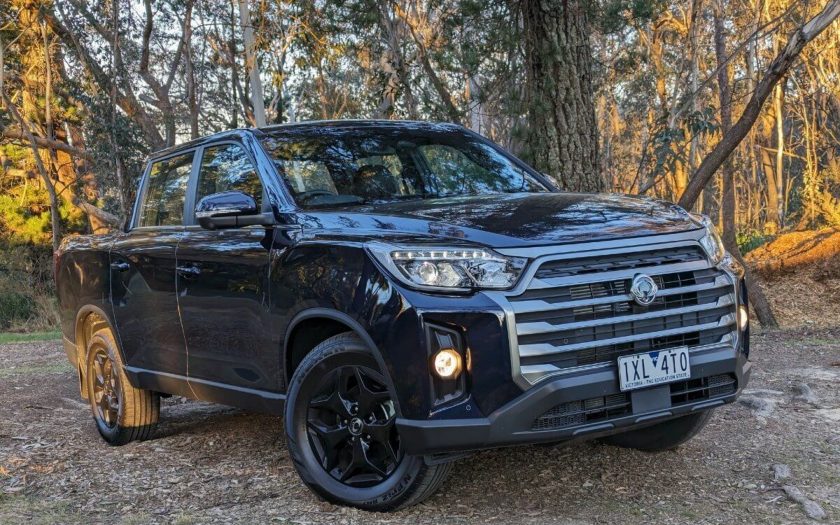Chris Riley tests the 2023 SsangYong Musso 4×4 dual cab ute with pricing, specs, ride and handling, safety, verdict and everything the over-50 driver needs to know.
Summary: The usually overlooked “other Korean” offers up value for money that used to be a Korean feature, but has now been ceded to the Chinese and Indians.
2023 SsangYong Musso 4×4 dual cab ute
Pricing: $40,000 (ELX SWB), $41,500 (ELX LWB), $45,000 (Ultimate SWB) all prices driveaway
Options: metallic paint $495, automatic transmission $2000, XLV Pack $1500
Warranty: Seven-years/unlimited km, seven years roadside assist, seven years capped price servicing
Safety: Not tested
Build location: South Korea
Engine: 2.2-litre turbo intercooled 4-cylinder diesel
Power: 133kW at 4000rpm
Torque: 400Nm at 1400-2800rpm (SWB), 420Nm at 1600-2600rpm (LWB)
Transmission: 6-speed manual (six-speed auto optional), all-wheel drive
Body: 5095mm (SWB, long), 5409mm (LWB); 1950mm (wide, both); 1840mm (SWB, high), 1855mm (LWB)
Kerb Weight: 2090kg (SWB), 2210kg (LWB)
Braked towing capacity: 3500kg
Tub capacity: 1011 litres (SWB), 1262 litres (LWB)
Tub dimensions: 1300mm (1600mm LWB) x 1570mm x 570mm, 1100mm between the wheel arches
Wheels: 18-inch alloy (17-inch alloy – LWB)
Spare: full size
Tyres: 255/60 R18 (SWB), 235/70 R17 (LWB)
Ground clearance: 215mm
Wading depth: 350mm
Turning circle: 11.8m (SWB), 12.2m (LWB)
Fuel tank capacity: 75 litres
Official consumption: 7.9-9.0L/100km (diesel)
Consumption on test: 7.1L/100 (500+km)
seniordriver consumption on test: not tested
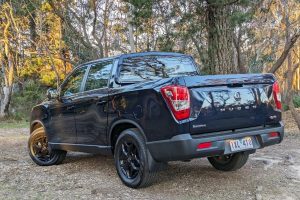
[review]
Well, hello. We’d almost forgotten about the other Korean – SsangYong.
After some financial woes and a subsequent restructure, SsangYong is back in business selling cars, with two SUVs and a 4×4 dual cab ute to offer.
Originally launched here in 2004, Musso was available as both a ute and SUV, the latter called the Musso Sports, that attracted buyers with its bargain price and Mercedes-sourced turbo-diesel.
These days, the ute and SUV have parted company, but it’s the Musso 4×4 dual cab ute that we are looking at here along with the company’s quest to grab a slice of the lucrative 4×4 market.
Launched in 2018, Musso is offered in two lengths with different sized tubs, but is not available in cab-chassis form with a metal tray replacement.

What’s it cost?
Musso comes with a choice of short or long wheelbase, both with the same 2.2-litre turbo-diesel.
Transmission is six-speed manual or six-speed auto, with drive to the rear wheels and selectable four-wheel drive, with 2Hi, 4Hi and 4Lo ranges.
The short wheelbase version is 5095mm long, with a 3100mm wheelbase and 1300mm long tub that can carry a 790kg payload.
At 5409mm, the XLV is 314mm longer, with a 3210mm wheelbase and 1600mm tub that is able to accommodate a full tonne (1020kg).
The shorter version is fitted with more benign five-link coil suspension and is a more sports focused model.
Tick the box for the long wheelbase option and it also comes with supportive leaf springs at the rear and is targeted at the work market.
Both versions have independent, double-wishbone front suspension.
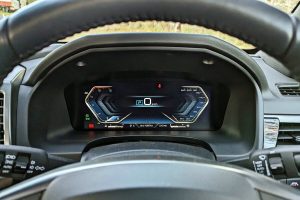
There are two grades from which to choose: ELX and Ultimate, with a couple of add on packs.
Prices start from $36,790 driveaway for the short wheelbase ELX with a six-speed manual.
The long wheelbase ELX is $38,290 driveaway, also with a manual.
Ultimate is priced from $43,090 driveaway, with an auto and metallic paint as part of the deal.
Adding the longer tub takes the price to $44,590 and topping it up with the Luxury Pack takes the total driveaway price to $47,590.
Metallic paint is $495, an auto adds $2000, the XLV Pack $1500 and Ultimate Pack $3000.
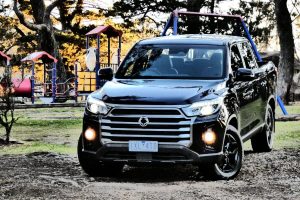
Even at these prices it leaves a lot of overhead for further optioning of the vehicle – and there’s plenty of them.
Sports bars, fender flares, side steps, tub liner, roller tonneau, under-body protection and sports suspension kits are available.
There’s a choice of six colours: Atlantic Blue is standard, Grand White, Silky White Pearl, Marble Grey, Space Black or Indian Red cost extra.
Standard kit includes cloth seats and manual air, 12.3-inch digital instrument cluster, 18-inch alloys, cruise control, LED daytime running lights, front fog lights, projector headlights with integrated LED turn signals, front and rear parking sensors, auto high beam, auto lights and wipers and an auto dimming mirror.
Ultimate adds 18-inch alloys, artificial leather, heated and cooled front seats, heated steering wheel, 360-degree camera and walk-away locking.
Our test vehicle was the short wheelbase Ultimate with the Luxury Pack fitted at $46,685 driveaway.
It adds Nappa leather, dual zone climate air, HID headlights, power-adjust front seats, powered driver lumbar support, heated rear seats and a power operated sunroof.
Infotainment consists of an 8.0-inch touchscreen, six-speaker audio, Bluetooth, AM/FM radio and wired Apple Carplay and Android Auto.
The front console offers two USB-A ports, a 12V/120W power outlet and a cigarette lighter (or in these more enlightened times, a 12-volt power outlet – Ed).
As yet Musso has not been rated for safety, but the safety story is a strong one with six airbags, a rear-view camera and Autonomous Emergency Braking (AEB) with Forward Collision Warning, Lane Departure Warning, Front Vehicle Start Warning, Active Rollover Protection and Driver Attention Warning.
Ultimate adds Blind Spot Detection (BSD), Rear Cross Traffic Warning (RCTW) Lane Change Collision Warning (LCW) and Tyre Pressure Monitoring System (TPMS).
Two ISOFIX and three top tether child seat mounts are provided.
The entry level model lacks reach adjustment for the steering wheel, but in a real faux-pas the rear centre seating position is equipped only with a lap seat belt.
It’s been a long time since we’ve seen one of these in a car.
Musso is covered by a 7-year unlimited kilometre warranty, with 7-year roadside assistance and 7-year capped price servicing.
The warranty extends to commercial use.
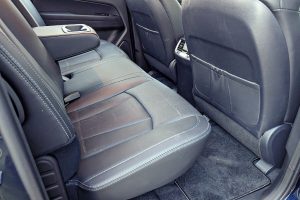
What’s it go like?
A 2.2 litre four-cylinder turbo-diesel produces 133kW of power at 4000 rpm and 400Nm of torque from 1400-2800 rpm.
The latter figure rises to 420Nm in the longer XLV but over a narrower band (from 1600 to 2600 rpm), presumably because it is expected to carry heavier loads.
The in-house diesel is paired with a six-speed manual or six-speed Japanese Aisin automatic, with part time high and low range four-wheel drive along with an auto-locking rear diff.
With a 75-litre tank, fuel consumption ranges from 7.9 to 9.0L/100km, depending on grade and wheelbase.
Nexen N Priz RH7 road tyres are fitted, with 255/60 18s for Musso and 235/70 17s for XLV – silver for ELX and black for Ultimate.
A full-size spare is provided.
Musso’s new body-on-frame platform is shared with the SsangYong Rexton.
The rigid body-on-frame design features high strength steel with eight large mounting points that contribute to lower levels of road noise and a more refined ride.
Weighing up to 2090kg, it can tow a 3500kg braked load and is equipped with trailer sway control as standard.
Steering is hydraulic in ELX but Ultimate scores speed sensitive power steering, with an 11.8-metre or 12.2-metre turning circle depending on wheelbase.
And, in something of a rarity in this segment, it comes with four-wheel disc brakes, ventilated at the front — most of the more fancied utes still come with rear drums.
We’ve always felt the tub in the Musso was too short, a bit stubby even compared to other utes.
The latest model addresses this issue, at least with the long wheelbase XLV which boasts one of the longest tubs in its class.
Having said that, we were still able to transport a heavy, power adjustable hospital-style bed in the short wheelbase, even though the end jutted over the tailgate.
Fortunately, it was only for a short distance.
Musso is push-button start and performance is surprisingly strong, both off the mark and in roll-on acceleration.
The feel is solid but nothing fancy, with heavy duty suspension that generates plenty of old school shake and shudder.
Large bumps are likely to produce some steering wheel backlash.
Rear legroom is limited, particularly for knees which press the back of the front seat.
In terms of dimensions, the standard tub is 1300mm x 1570mm x 570mm, with a width of 1100mm between wheel arches.
The longer tub is 1600mm, with all other dimensions the same.
The first holds 1011 litres and the longer tub is 1262 litres – an increase of almost 25 percent more.
In terms of off-road capability, Musso presents mainly as a farm or worksite vehicle.
Weekend warriors will need to invest in a lift kit and some chunkier all-terrain rubber.
Low-range gearing and a locking rear diff deliver plenty of traction, with hill descent control as well as hill start assist to help.
But a modest 215mm of ground clearance and equally shy wading depth of 350mm will be limiting factors, the former when it comes to negotiating tricky fire trails with some rock hopping involved.
But the foundations are good and Musso certainly has potential.
We were getting an impressive 7.1L/100km after more than 500km.

What we like
- Solid feel
- Value for money
- 7-year warranty
- Rear disc brakes
- Back seat aircon outlets
What we don’t like
- No tonneau
- No digital radio
- No satnav
- Rear lap seatbelt
- No adaptive cruise control
- No cab-chassis option
What over-50s drivers need to know
Musso is proverbial value for money.
The styling is generic but the basics are there, it just needs fine tuning to meet market expectations.
To wit, we live in a digital world and that means digital radio and a wireless charge pad need to be added.
It’s got the desired black wheels but a sports bar and soft tonneau (at minimum) are needed to complete the look that 4×4 dual cab buyers want.
CarPlay and Android Auto are okay when they work, but when you’re out in the sticks and run out of reception – built-in navigation is your friend.
These electronic aids are all available in other markets, but have obviously been removed to keep down the price.
If you can live without these features, Musso shines as a bargain in a field of increasingly pricey dual cab utes.
Older drivers will find it easy to get in and out of and the relaxed pace of the diesel engine is welcome too.
While resale could be an issue, Musso presents as a quality product with more than enough off-road capability for most, at a price that is frankly difficult to ignore – don’t forget that Nappa leather and cooled front seats.
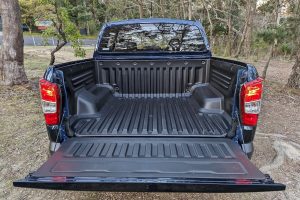
seniordriver comments
SsangYong has been selling quietly on the Australian market for quite some years. I do remember testing a Musso Sports many years ago that put me off the brand for quite some time. Thankfully, things are on a much better footing now.
As the Korean manufacturers have moved upmarket, their bargain basement positioning has been taken over by the new Chinese brands, but SsangYong is holding the fort, and offering excellent value for money. SsangYong Musso easily undercuts such utes as the Ford Ranger, Isuzu D-Max, Mazda BT-50, Nissan Navara, Toyota HiLux and Volkswagen Amarok. About the only competitors that can challenge the Musso on price are the GWM Cannon ute, LDV ute, Mitsubishi Triton (although the new model may cost more) and the Mahindra PikUp.
The absence of a cab/chassis format will limit appeal to the trade market, but is of little interest to most seniordriveraus readers. Payloads of 790kg (short wheelbase) and 1020kg (long wheelbase) will be strong selling points.
Leaf springs at the rear of the LWB variant point towards its more work-based focus, while the coil suspension in the SWB model will deliver a ride closer to what most people will want.
The absence of an ANCAP rating is of some concern, although there appears to be a full complement of safety equipment (apart from that lap belt in the rear central seating position!) And four-wheel disc brakes are a bonus in this class.
The seven/seven/seven warranty (year/roadside assist/capped price servicing) was a SsangYong feature quite early on and adds peace of mind to the equation. It also, as Chris points out, extends to commercial use.
